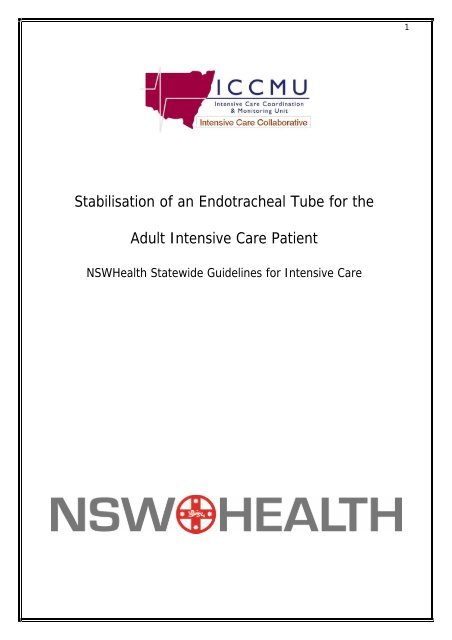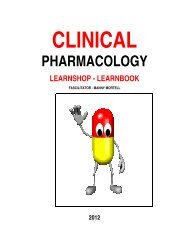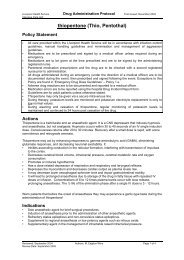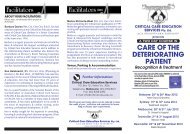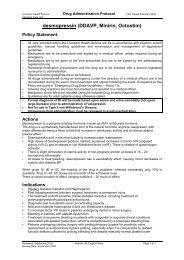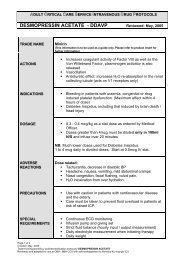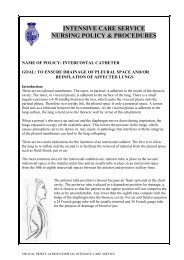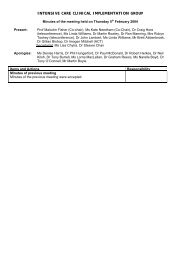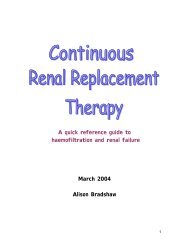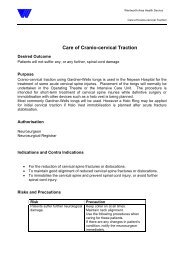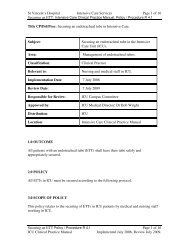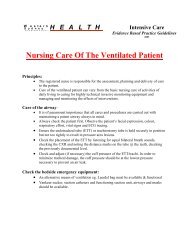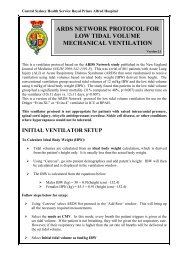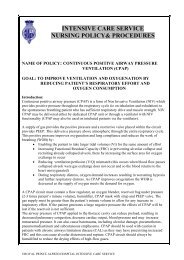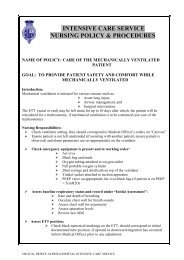Stabilisation of an Endotracheal Tube for the Adult Intensive Care ...
Stabilisation of an Endotracheal Tube for the Adult Intensive Care ...
Stabilisation of an Endotracheal Tube for the Adult Intensive Care ...
You also want an ePaper? Increase the reach of your titles
YUMPU automatically turns print PDFs into web optimized ePapers that Google loves.
<strong>Stabilisation</strong> <strong>of</strong> <strong>an</strong> <strong>Endotracheal</strong> <strong>Tube</strong> <strong>for</strong> <strong>the</strong><br />
<strong>Adult</strong> <strong>Intensive</strong> <strong>Care</strong> Patient<br />
NSWHealth Statewide Guidelines <strong>for</strong> <strong>Intensive</strong> <strong>Care</strong><br />
1
Full Title <strong>Stabilisation</strong> <strong>of</strong> <strong>an</strong> endotracheal tube <strong>for</strong> <strong>the</strong> adult intensive care patient:<br />
NSW Statewide Clinical Practice Guidelines<br />
Short Title <strong>Stabilisation</strong> <strong>of</strong> <strong>an</strong> ETT<br />
Guideline Owner NSW Health<br />
<strong>Intensive</strong> <strong>Care</strong> Coordination <strong>an</strong>d Monitoring Unit<br />
Authors Kaye Rolls RN ACC BAppSc(Syd) CNC ICCMU<br />
Anne Gardner Pr<strong>of</strong>essor <strong>of</strong> Nursing, James Cook University<br />
ETT Guideline Development Network Members Kaye Rolls CNC<br />
J<strong>an</strong>elle Painter CNE<br />
Rachel Anderson NUM<br />
J<strong>an</strong>ine Learmont CNE<br />
Deb Poynting CNC<br />
Ali Ruiz CNS<br />
David S<strong>an</strong>chez CNC<br />
ETT GDN Academic Facilitators A/Pr<strong>of</strong>essor Anne Gardner (Chair, <strong>Intensive</strong> <strong>Care</strong> Collaborative Consensus<br />
Development Conference)<br />
Pr<strong>of</strong>essor S<strong>an</strong>dy Middleton<br />
<strong>Intensive</strong> <strong>Care</strong> Collaborative - Project Coordinator Kaye Rolls RN ACC BAppSc(Syd)<br />
CNC ICCMU<br />
<strong>Intensive</strong> <strong>Care</strong> Collaborative – Academic<br />
Convenor<br />
Pr<strong>of</strong>essor Doug Elliott RN PhD MappSc BappSc ICCert<br />
Director <strong>of</strong> Research, Faculty <strong>of</strong> Nursing, Midwifery <strong>an</strong>d Health<br />
University <strong>of</strong> Technology Sydney<br />
ICCMU Director Dr Anthony Burrell BA MBBS FANZCA FJFICM<br />
ICCMU - M<strong>an</strong>ager Di<strong>an</strong>e Kowal RN<br />
Version Number<br />
Year Published / implementation<br />
Year <strong>for</strong> Review<br />
Endorsement Org<strong>an</strong>isations<br />
Funding<br />
Related NSWHealth Policies <strong>an</strong>d Guidelines Policy Directive – Infection Control Policy (PD2007_046)<br />
Disclaimer<br />
This clinical practice guideline (CPG) is aimed at providing <strong>the</strong> clinici<strong>an</strong>s <strong>of</strong> NSW intensive care units (ICU) with<br />
recommendations to frame <strong>the</strong> development <strong>of</strong> policies <strong>an</strong>d procedures related to <strong>Stabilisation</strong> <strong>of</strong> <strong>an</strong> endotracheal tube <strong>for</strong> <strong>the</strong><br />
adult intensive care patient<br />
This CPG is a distillation <strong>of</strong> several processes: <strong>an</strong> integrative review <strong>of</strong> <strong>the</strong> literature (available up to December 2006); <strong>an</strong><br />
evaluation <strong>of</strong> how this literature applies to <strong>the</strong> NSW intensive care context; <strong>the</strong> extensive clinical knowledge <strong>of</strong> <strong>the</strong> guideline<br />
development network members (GDN); <strong>an</strong>d a consensus development process.<br />
The CPG is not intended to replace <strong>the</strong> critical evaluation processes that underpin <strong>the</strong> development <strong>of</strong> local policy <strong>an</strong>d<br />
procedure nor a clinici<strong>an</strong>’s judgment in <strong>an</strong> individual case.<br />
Users <strong>of</strong> this CPG must critically evaluate this CPG as it relates to local circumst<strong>an</strong>ces <strong>an</strong>d <strong>an</strong>y ch<strong>an</strong>ges in <strong>the</strong> literature that may<br />
have occurred since <strong>the</strong> dates <strong>of</strong> <strong>the</strong> literature review. In addition NSWHealth clinici<strong>an</strong>s must review NSW state government<br />
policy documents to identify <strong>an</strong>y directives that may relate to this clinical practice.<br />
These guidelines will be updated every 3 years.<br />
These guidelines are intended <strong>for</strong> use in adults only.<br />
NSW Health holds copyright <strong>of</strong> this CPG. No permission is given to redistribute, publish or commercialise this material in <strong>an</strong>y<br />
way. The user agrees that in <strong>the</strong> event that part <strong>of</strong> <strong>the</strong> material in this CPG is reproduced or quoted, ei<strong>the</strong>r in whole or in part,<br />
that <strong>the</strong> copyright owners name <strong>an</strong>d interest in <strong>the</strong> matter will be acknowledged.<br />
Permission MUST be gr<strong>an</strong>ted to publish this CPG as a st<strong>an</strong>d-alone document on a website o<strong>the</strong>r th<strong>an</strong> those <strong>of</strong> NSWHealth. This<br />
permission may be obtained by contacting NSW <strong>Intensive</strong> <strong>Care</strong> Coordination <strong>an</strong>d Monitoring Unit (ICCMU).<br />
Telephone: + 61 2 4734 1585, Fax: + 61 2 4734 1586, Email: iccmu@wahs.nsw.gov.au M<br />
2
Index<br />
Abbreviations <strong>an</strong>d Acronyms......................................................................................4<br />
Executive Summary..........................................................................................................5<br />
Clinical Practice Guideline .................................................................................................7<br />
1. Introduction ...............................................................................................7<br />
2. Scope .......................................................................................................8<br />
3. Purpose.....................................................................................................8<br />
4. Target Clinici<strong>an</strong>s..........................................................................................8<br />
5. How <strong>the</strong> guideline was developed ...................................................................8<br />
6. How to use guideline....................................................................................9<br />
7. Format <strong>of</strong> guideline......................................................................................9<br />
8. Level <strong>of</strong> Evidence taxonomy ..........................................................................9<br />
9. Infection Control .........................................................................................9<br />
10. Occupational Health <strong>an</strong>d Safety......................................................................9<br />
Process <strong>of</strong> Guideline Development................................................................................... 18<br />
Academic Facilitators ........................................................................................ 20<br />
External Validation Process ................................................................................ 21<br />
Integrative Literature Review .......................................................................................... 23<br />
Introduction.................................................................................................... 23<br />
1. Literature Search Protocol ........................................................................... 23<br />
2. Literature Review Process ........................................................................... 23<br />
3. Literature Syn<strong>the</strong>sis Process ........................................................................ 23<br />
4. Taxonomy <strong>for</strong> level <strong>of</strong> evidence <strong>an</strong>d grade <strong>of</strong> recommendation........................... 24<br />
5. Summary Tables <strong>of</strong> Research Papers included ................................................. 26<br />
6. Summary Table <strong>of</strong> Research Papers not included ............................................. 27<br />
Appendix 1: Data Extraction Tools ........................................................................... 28<br />
Appendix 2: Survey <strong>of</strong> current NSW ETT <strong>an</strong>d tracheostomy clinical practices .............. 30<br />
Appendix 3: Consensus Results <strong>for</strong> ETT-GDN............................................................ 31<br />
References .................................................................................................................... 32<br />
Table Title Page<br />
Table 1 Recommendations <strong>for</strong> Practice 6<br />
Table 2 External Validation P<strong>an</strong>el Members 22<br />
Table 3 Results <strong>of</strong> EVP process 22<br />
Table 4 NHMRC Level <strong>of</strong> Evidence & papers identified 24<br />
Table 5 NHMRC Grading <strong>of</strong> evidence 24<br />
3
Abbreviations <strong>an</strong>d Acronyms<br />
CI Confidence interval<br />
CNC Clinical Nurse Consult<strong>an</strong>t<br />
CNE Clinical Nurse Specialist<br />
CPG Clinical Practice Guideline<br />
ETT <strong>Endotracheal</strong> tube<br />
EVP External Validation P<strong>an</strong>el<br />
GDN Guideline Development Network<br />
HDU High Dependency Unit<br />
ICC <strong>Intensive</strong> <strong>Care</strong> Collaborative<br />
ICC-CDC <strong>Intensive</strong> <strong>Care</strong> Collaborative – Consensus Development Conference<br />
ICCMU NSW <strong>Intensive</strong> <strong>Care</strong> Coordination <strong>an</strong>d Monitoring Unit<br />
ICU <strong>Intensive</strong> <strong>Care</strong> Unit<br />
OR Odds Ratio<br />
PICO Population Intervention Comparison Outcome<br />
SR Systematic Review<br />
UEX Unexpected extubation<br />
4
Executive Summary<br />
Invasive ventilation is common practice in <strong>Intensive</strong> <strong>Care</strong> (IC) <strong>for</strong> patients with serious<br />
breathing difficulties. This is achieved through <strong>the</strong> insertion <strong>of</strong> <strong>an</strong> endotracheal tube (ETT)<br />
into <strong>the</strong> trachea via <strong>the</strong> mouth or nose <strong>an</strong>d attaching this tube to a ventilator. Ensuring <strong>the</strong><br />
position <strong>of</strong> <strong>the</strong> ETT remains stable, within <strong>the</strong> patient’s airway, is a high clinical priority as<br />
tube migration, endobronchial intubation <strong>an</strong>d unexpected extubation (UEX) have potentially<br />
life threatening sequelae. Additionally ETT movement may damage a patient’s airway <strong>an</strong>d is<br />
a source <strong>of</strong> signific<strong>an</strong>t discom<strong>for</strong>t <strong>for</strong> <strong>the</strong> invasively ventilated patient.<br />
The purpose <strong>of</strong> this clinical practice guideline (CPG) is to provide intensive care clinici<strong>an</strong>s<br />
with recommendations to guide clinical practice <strong>an</strong>d <strong>the</strong> development <strong>of</strong> local policy. A<br />
literature review was undertaken using <strong>the</strong> PICO (Population Intervention Comparison<br />
Outcome) model which identified a systematic review (SR) (Gardner et al 2005). The SR<br />
exposed <strong>the</strong> lack <strong>of</strong> literature regarding ETT stabilisation practices <strong>the</strong>re<strong>for</strong>e <strong>the</strong><br />
recommendations are focused on <strong>the</strong> principles <strong>of</strong> ETT stablisation not specific methods per<br />
se. The recommendations contained in this CPG have been framed by: 1) available literature<br />
including Gardner SR; 2) a survey <strong>of</strong> current clinical practices (Appendix 2); <strong>an</strong>d 3)<br />
experience <strong>of</strong> guideline development network members (GDN). The recommendations were<br />
developed during a facilitated meeting at <strong>the</strong> <strong>Intensive</strong> <strong>Care</strong> Collaborative Consensus<br />
Development Conference (ICC-CDC) held on December 1 2006. Following this group<br />
consensus was achieved using <strong>an</strong> emailed consensus <strong>for</strong>m (<strong>for</strong> results see Appendix 3).<br />
External validation <strong>of</strong> <strong>the</strong> guideline was achieved using a Delphi p<strong>an</strong>el, conducted in May<br />
2007, using <strong>an</strong> emailed voting <strong>for</strong>m with <strong>the</strong> same level <strong>of</strong> consensus as <strong>the</strong> GDN. Although<br />
<strong>the</strong>se recommendations have been developed <strong>an</strong>d validated in a systematic way <strong>the</strong>y are not<br />
underpinned by a strong body <strong>of</strong> evidence <strong>an</strong>d as such <strong>the</strong> guideline user must apply due<br />
diligence in <strong>the</strong> application <strong>of</strong> <strong>the</strong> recommendations to <strong>the</strong>ir own clinical setting. It is<br />
strongly recommended that <strong>the</strong> guideline user check <strong>the</strong> literature <strong>for</strong> studies published since<br />
J<strong>an</strong>uary 2007 that may impact on <strong>the</strong> clinical practice <strong>of</strong> ETT stabilisation.<br />
Consensus Opinion<br />
Where no evidence could be applied consensus opinion<br />
developed by:<br />
1. Formulation <strong>of</strong> recommendation through discussion<br />
2. Assignment <strong>of</strong> agreement by individual particip<strong>an</strong>ts<br />
(Likert 1-9)<br />
3. Consensus set at medi<strong>an</strong> <strong>of</strong> 7<br />
5
Table 1: Recommendations <strong>for</strong> Practice<br />
Number Statement<br />
1a<br />
1b<br />
1c<br />
2<br />
2a<br />
2b<br />
2c<br />
3<br />
4<br />
Two clinici<strong>an</strong>s must always be present to ch<strong>an</strong>ge <strong>the</strong> method <strong>of</strong> securing<br />
<strong>the</strong> endotracheal tube. One clinici<strong>an</strong> ch<strong>an</strong>ges <strong>the</strong> tapes while <strong>the</strong> o<strong>the</strong>r<br />
holds <strong>the</strong> ETT in position.<br />
Of <strong>the</strong> two clinici<strong>an</strong>s ch<strong>an</strong>ging <strong>the</strong> ETT securement at least one clinici<strong>an</strong><br />
must be <strong>an</strong> experienced member <strong>of</strong> <strong>the</strong> critical care team.<br />
The method <strong>of</strong> stabilisation should be consistent within units to promote<br />
staff pr<strong>of</strong>iciency in safe <strong>an</strong>d effective ET stabilisation.<br />
The methods <strong>for</strong> securing <strong>an</strong> ETT c<strong>an</strong> be divided into 3 groups: twill tape;<br />
adhesive tape <strong>an</strong>d m<strong>an</strong>ufactured devices. There is minimal research<br />
evidence to support <strong>the</strong> use <strong>of</strong> <strong>an</strong>y one method over <strong>the</strong> o<strong>the</strong>r two.<br />
However, <strong>the</strong>re are principles that c<strong>an</strong> in<strong>for</strong>m this decision.<br />
The use <strong>of</strong> adhesive tape/devices should be avoided in patients with<br />
impaired facial skin integrity (<strong>for</strong> example burns, cellulitis).<br />
The use <strong>of</strong> adhesive tape/devices should be avoided in patients with<br />
extreme diaphoresis.<br />
The use <strong>of</strong> adhesive tape/devices should be avoided in male patients with<br />
beards.<br />
<strong>Endotracheal</strong> tube securing methods that may cause venous occlusion<br />
should be avoided <strong>for</strong> patients at risk <strong>of</strong> raised intracr<strong>an</strong>ial pressure<br />
There is minimal research evidence to support <strong>the</strong> frequency <strong>of</strong> renewal <strong>of</strong><br />
ETT stabilisation methods. However <strong>the</strong>re are principles that support <strong>the</strong><br />
decision about frequency.<br />
4a The ETT securing method should be renewed if <strong>the</strong> tapes are soiled.<br />
4b<br />
4c<br />
4d<br />
4e<br />
4f<br />
5<br />
6<br />
The ETT securing method should be renewed if <strong>the</strong> ETT is able to<br />
migrate/move more th<strong>an</strong> 1 cm.<br />
When using cotton tape <strong>the</strong> ETT securing method should be renewed if a<br />
clinici<strong>an</strong> is unable to insert two fingers between tape <strong>an</strong>d skin.<br />
The ETT securing method should be renewed if <strong>the</strong> ETT position on CXR is<br />
incorrect (tip should be 2.5cm above <strong>the</strong> carina).<br />
The ETT securing method should be renewed if <strong>the</strong> method <strong>of</strong> tube<br />
stabilisation is not consistent with Unit practice.<br />
In <strong>the</strong> absence <strong>of</strong> o<strong>the</strong>r indications <strong>the</strong> tube stabilisation method should be<br />
renewed at least once every 24 hrs to enable skin <strong>an</strong>d mucosal<br />
assessment <strong>an</strong>d to prevent sustained pressure on a single point.<br />
Assessment <strong>of</strong> <strong>the</strong> face should include <strong>the</strong> condition <strong>of</strong> <strong>the</strong> skin <strong>of</strong> <strong>the</strong> face,<br />
ears <strong>an</strong>d back <strong>of</strong> neck. In addition <strong>the</strong> assessment <strong>of</strong> <strong>the</strong> oral cavity<br />
should be inline with <strong>the</strong> assessment completed <strong>for</strong> adequate oral hygiene<br />
<strong>an</strong>d includes <strong>the</strong> mouth, teeth, gums, tongue, mucous membr<strong>an</strong>es, lips<br />
<strong>an</strong>d barriers to mouth care.<br />
The ventilator tubing should be supported by a ventilator arm that keeps<br />
<strong>the</strong> patient’s head in <strong>the</strong> midline <strong>an</strong>d prevents pressure on <strong>the</strong> lips.<br />
6<br />
Grade <strong>of</strong><br />
recommendation<br />
Consensus<br />
Opinion<br />
Consensus<br />
Opinion<br />
Consensus<br />
Opinion<br />
Consensus<br />
Opinion<br />
Consensus<br />
Opinion<br />
Consensus<br />
Opinion<br />
Consensus<br />
Opinion<br />
Consensus<br />
Opinion<br />
Consensus<br />
Opinion<br />
Consensus<br />
Opinion<br />
Consensus<br />
Opinion<br />
Consensus<br />
Opinion<br />
Consensus<br />
Opinion<br />
Consensus<br />
Opinion<br />
Consensus<br />
Opinion<br />
Consensus<br />
Opinion<br />
Consensus<br />
Opinion
Clinical Practice Guideline<br />
1. Introduction<br />
Invasive ventilation is common practice in <strong>an</strong> intensive care unit (ICU) <strong>for</strong> patients with<br />
serious breathing difficulties. Ventilation is achieved through <strong>the</strong> insertion <strong>of</strong> <strong>an</strong> ETT into <strong>the</strong><br />
trachea via <strong>the</strong> mouth or nose <strong>an</strong>d attaching this tube to a ventilator. It is vitally import<strong>an</strong>t<br />
that <strong>the</strong> position <strong>of</strong> <strong>the</strong> ETT remain stable <strong>for</strong> several reasons:<br />
1. as this tube is fulfilling <strong>the</strong> function <strong>of</strong> a patient’s airway, <strong>the</strong> unexpected removal<br />
<strong>of</strong> <strong>the</strong> tube (unpl<strong>an</strong>ned extubation UEX) poses a signific<strong>an</strong>t risk to <strong>the</strong> patient’s<br />
survival;<br />
2. <strong>the</strong> tube needs to be stable to ensure optimal ventilation <strong>an</strong>d const<strong>an</strong>t supply <strong>of</strong><br />
oxygen; <strong>an</strong>d<br />
3. ETT movement within <strong>the</strong> trachea may cause local trauma <strong>an</strong>d is a signific<strong>an</strong>t<br />
source <strong>of</strong> discom<strong>for</strong>t <strong>for</strong> <strong>the</strong> patient.<br />
There are also several clinical concerns to address with respect to patient safety when<br />
attempting to achieve a stable ETT. These include:<br />
1. Preventing migration <strong>of</strong> <strong>the</strong> ETT <strong>an</strong>d unpl<strong>an</strong>ned extubation;<br />
2. Maintaining alignment <strong>of</strong> <strong>the</strong> ETT within trachea;<br />
3. Skin integrity <strong>of</strong> <strong>the</strong> face <strong>an</strong>d neck; <strong>an</strong>d<br />
4. Mainten<strong>an</strong>ce <strong>of</strong> adequate levels <strong>of</strong> venous return from <strong>the</strong> head through <strong>the</strong> jugular<br />
veins.<br />
There are three main methods <strong>of</strong> achieving tube stabilisation: 1) tying <strong>the</strong> ETT to <strong>the</strong><br />
patient’s head using white cotton tape; 2) taping <strong>the</strong> ETT to <strong>the</strong> patient’s face using medical<br />
adhesive tape; or 3) using a commercial tube holder. There is a lack <strong>of</strong> research into <strong>the</strong><br />
most effective <strong>for</strong>m <strong>of</strong> ETT stabilisation with a recent systematic review being unable to<br />
identify a superior method (Gardner, Hughes et al. 2005). A recent survey <strong>of</strong> NSW ICUs <strong>an</strong>d<br />
High Dependency Units (HDUs) with <strong>the</strong> capacity to provide short term ventilation was<br />
conducted to determine local ETT m<strong>an</strong>agement practices [see Appendix 2]. Particip<strong>an</strong>ts<br />
from 41 <strong>of</strong> <strong>the</strong> 44 eligible units responded (response rate 93%). The white cotton tape<br />
method was <strong>the</strong> most frequently reported method <strong>for</strong> stabilising <strong>the</strong> position <strong>of</strong> <strong>an</strong> ETT<br />
(78%, n=32) however nine units reported using this method in conjunction with a<br />
commercial product <strong>an</strong>d a fur<strong>the</strong>r seven units reported using this method in conjunction with<br />
medical adhesive tape. Renewing or ch<strong>an</strong>ging <strong>the</strong> ETT tapes is a procedure completed<br />
frequently by critical care nurses, however, only 41% (n=17) <strong>of</strong> NSW ICUs/HDUs had a<br />
7
written guideline <strong>for</strong> this procedure <strong>an</strong>d only nine <strong>of</strong> <strong>the</strong>se protocols were less th<strong>an</strong> two<br />
years old.<br />
The recommendations in this guideline were in<strong>for</strong>med by <strong>an</strong> integrative literature review<br />
covering <strong>the</strong> publication years <strong>of</strong> 1980-2006 [See Integrative literature review] <strong>an</strong>d <strong>the</strong><br />
clinical experience <strong>of</strong> <strong>the</strong> guideline development network members who were senior<br />
clinici<strong>an</strong>s from NSW ICUs. Due to <strong>the</strong> lack <strong>of</strong> <strong>an</strong>y evidence <strong>the</strong>se recommendations were<br />
considered to be <strong>the</strong> key guiding principles that a protocol writer should incorporate into<br />
whatever method/s <strong>of</strong> ETT stabilisation are most appropriate <strong>for</strong> <strong>the</strong>ir patient mix <strong>an</strong>d clinical<br />
setting.<br />
2. Scope<br />
The recommendations in this guideline are focussed on <strong>the</strong> clinical practices used to<br />
maintain <strong>the</strong> optimal position <strong>of</strong> <strong>an</strong> endotracheal tube that is inserted into <strong>an</strong> adult in <strong>an</strong><br />
intensive care unit referred to as ‘stabilisation <strong>of</strong> <strong>an</strong> endotracheal tube’. The following issues,<br />
although considered import<strong>an</strong>t, are beyond <strong>the</strong> scope <strong>of</strong> this guideline:<br />
• Issues related to patient autonomy such as patient consent <strong>an</strong>d expl<strong>an</strong>ation <strong>of</strong><br />
procedure.<br />
• Documentation <strong>of</strong> patient assessment <strong>an</strong>d outcomes <strong>of</strong> nursing procedures.<br />
3. Purpose<br />
This guideline has been developed to provide intensive care clinici<strong>an</strong>s with recommendations<br />
or principles to guide <strong>the</strong> development <strong>of</strong> local policy/procedure related to stabilisation <strong>of</strong> <strong>an</strong><br />
endotracheal tube. The guideline does not address <strong>the</strong> minutiae <strong>of</strong> this practice.<br />
4. Target Clinici<strong>an</strong>s<br />
The target clinici<strong>an</strong>s are registered nurses <strong>an</strong>d medical <strong>of</strong>ficers working in NSW ICUs. This<br />
includes both beginner <strong>an</strong>d experienced clinici<strong>an</strong>s <strong>an</strong>d assumes knowledge <strong>of</strong>: <strong>an</strong>atomy <strong>an</strong>d<br />
physiology <strong>of</strong> <strong>the</strong> head <strong>an</strong>d neck; <strong>the</strong> purpose <strong>of</strong> <strong>an</strong> ETT <strong>an</strong>d import<strong>an</strong>ce <strong>of</strong> mainten<strong>an</strong>ce <strong>of</strong><br />
correct position; possible sequelae associated with <strong>the</strong> different stabilisation methods; <strong>an</strong>d<br />
<strong>the</strong> consequences <strong>of</strong> unpl<strong>an</strong>ned extubation.<br />
5. How <strong>the</strong> guideline was developed<br />
This guideline was developed by <strong>the</strong> ETT guideline development network (GDN) comprised<br />
<strong>of</strong> six senior nursing clinici<strong>an</strong>s <strong>an</strong>d three nursing academics, within <strong>the</strong> ICCMU <strong>Intensive</strong> <strong>Care</strong><br />
Collaborative project. The recommendations were developed during round table discussions<br />
at ICC-CDC held on December 1 2006. Consensus was achieved by a postal round whereby<br />
a consensus <strong>for</strong>m was sent to GDN members who assigned <strong>the</strong>ir level <strong>of</strong> agreement with<br />
8
each recommendation statement using a likert scale <strong>of</strong> 1-9. Consensus was set as a medi<strong>an</strong><br />
<strong>of</strong> at least 7 <strong>an</strong>d <strong>the</strong> results are set out in Appendix B. This process is described in greater<br />
detail under ‘Process <strong>of</strong> guideline development’. Additionally external validation <strong>of</strong> <strong>the</strong><br />
guideline was completed using a Delphi p<strong>an</strong>el (see pages 20-21).<br />
6. How to use guideline<br />
The recommendations in this guideline should be used to in<strong>for</strong>m local policy covering care <strong>of</strong><br />
<strong>the</strong> ventilated patient including intubation <strong>an</strong>d stabilisation <strong>of</strong> <strong>an</strong> ETT.<br />
7. Format <strong>of</strong> guideline<br />
The Guideline is presented in three main sections:<br />
• Section 1 contains <strong>the</strong> recommendation statements <strong>an</strong>d supporting narrative;<br />
• Section 2 is a detailed expl<strong>an</strong>ation <strong>of</strong> <strong>the</strong> Guideline development process;<br />
• Section 3 contains <strong>the</strong> integrative literature review.<br />
8. Level <strong>of</strong> Evidence taxonomy<br />
The NHMRC taxonomy (NHMRC 2005) was chosen by <strong>the</strong> Academic facilitators p<strong>an</strong>el as <strong>the</strong><br />
most appropriate framework to grade <strong>the</strong> levels <strong>of</strong> evidence <strong>an</strong>d recommendations, on <strong>the</strong><br />
basis <strong>of</strong> its useability <strong>an</strong>d application to <strong>the</strong> Australi<strong>an</strong> health care context. Where evidence<br />
was limited or not available <strong>the</strong> GDN members discussed <strong>the</strong> issue <strong>an</strong>d developed a<br />
recommendation statement using <strong>the</strong>ir own clinical experience. Consensus was achieved by<br />
using <strong>the</strong> likert scale with a medi<strong>an</strong> <strong>of</strong> at lease 7 set as agreement.<br />
9. Infection Control<br />
Prevention <strong>of</strong> infection is <strong>an</strong> import<strong>an</strong>t aspect <strong>of</strong> <strong>an</strong>y clinical practice <strong>an</strong>d guideline users are<br />
directed to NSWHealth Policy directive (PD2007_036) <strong>an</strong>d local policy to comprehensively<br />
identify <strong>the</strong> infection control elements <strong>of</strong> this clinical practice. These elements include but<br />
are not limited to: use <strong>of</strong> personal protective equipment, good h<strong>an</strong>d hygiene, correct<br />
disposal <strong>of</strong> equipment <strong>an</strong>d medical waste <strong>an</strong>d isolation <strong>of</strong> infectious patients.<br />
When renewing ETT tapes both <strong>the</strong> operator <strong>an</strong>d assist<strong>an</strong>t are at high risk <strong>for</strong> contact with<br />
potentially contaminated patient secretions <strong>the</strong>re<strong>for</strong>e personal protective equipment<br />
including goggles, gloves <strong>an</strong>d masks must be worn.<br />
10. Occupational Health <strong>an</strong>d Safety<br />
Guideline users are directed to local policy <strong>an</strong>d procedures related to occupational health <strong>an</strong>d<br />
safety to ensure operator safety whilst completing this procedure.<br />
9
Recommendations <strong>for</strong> Practice<br />
The purpose <strong>of</strong> <strong>the</strong> recommendations listed here is to in<strong>for</strong>m <strong>the</strong> development <strong>of</strong> local policy<br />
regarding <strong>the</strong> stabilisation <strong>of</strong> <strong>an</strong> endotracheal tube (ETT). The paucity <strong>of</strong> research literature<br />
regarding this topic has limited <strong>the</strong> ETT guideline development network’s (ETT-GDN) ability<br />
to <strong>for</strong>mulate specific recommendations regarding <strong>the</strong> optimal method <strong>of</strong> stabilisation <strong>an</strong>d<br />
related issues. There<strong>for</strong>e <strong>the</strong>se recommendations are considered to be <strong>the</strong> key principles<br />
that should be addressed when a clinici<strong>an</strong> is developing local policy.<br />
The decision to ch<strong>an</strong>ge or renew a patient’s ETT stabilisation method is influenced by several<br />
factors however must be made on <strong>the</strong> basis <strong>of</strong> ensuring <strong>the</strong> ETT remains in <strong>the</strong> optimal<br />
position. These factors may include:<br />
a. Is <strong>the</strong> patient’s ETT in <strong>the</strong> optimal position <strong>an</strong>d will it remain <strong>the</strong>re?<br />
If <strong>the</strong> ETT is in imminent d<strong>an</strong>ger <strong>of</strong> UEX or endobronchial intubation <strong>the</strong> clinici<strong>an</strong><br />
should prioritise correcting this.<br />
b. What is <strong>the</strong> patient’s current clinical status?<br />
Since <strong>the</strong> risk <strong>of</strong> UEX is heightened during <strong>the</strong> procedure if a patient’s clinical<br />
status is critical <strong>an</strong>d unstable ch<strong>an</strong>ging <strong>the</strong> ETT stabilisation method may not be<br />
warr<strong>an</strong>ted unless <strong>the</strong> ETT position is unstable.<br />
c. What is <strong>the</strong> patient’s level <strong>of</strong> consciousness?<br />
A patient who is restless, agitated or has <strong>an</strong> inadequate level <strong>of</strong> sedation is more<br />
likely to self-extubate (Boulain 1998) <strong>an</strong>d this risk will be increased when <strong>the</strong><br />
stabilisation method is being renewed.<br />
d. What is <strong>the</strong> impact <strong>of</strong> <strong>the</strong> ETT stabilisation method on <strong>the</strong> patient’s venous return<br />
from <strong>the</strong> head <strong>an</strong>d facial <strong>an</strong>d neck skin <strong>an</strong>d oral cavity?<br />
e. Has <strong>the</strong> method <strong>of</strong> ETT stabilisation been renewed within <strong>the</strong> past 24 hours?<br />
f. Is <strong>the</strong> method <strong>of</strong> ETT stabilisation consistent with unit guidelines?<br />
The recommendations <strong>for</strong> practice have been grouped under <strong>the</strong> following headings<br />
1. Clinical Govern<strong>an</strong>ce<br />
2. Choice <strong>of</strong> Method<br />
3. Patients with risk <strong>of</strong> raised intracr<strong>an</strong>ial pressure<br />
4. When to ch<strong>an</strong>ge ETT <strong>Stabilisation</strong> method<br />
5. Assessment<br />
6. General<br />
10
Number Statement: Clinici<strong>an</strong> Govern<strong>an</strong>ce<br />
Two clinici<strong>an</strong>s must always be present to ch<strong>an</strong>ge <strong>the</strong><br />
Grade <strong>of</strong><br />
recommendation<br />
1a<br />
1b<br />
1c<br />
method <strong>of</strong> securing <strong>the</strong> endotracheal tube. One clinici<strong>an</strong><br />
ch<strong>an</strong>ges <strong>the</strong> tapes while <strong>the</strong> o<strong>the</strong>r holds <strong>the</strong> ETT in position.<br />
Of <strong>the</strong> two clinici<strong>an</strong>s ch<strong>an</strong>ging <strong>the</strong> ETT securement at least<br />
one clinici<strong>an</strong> must be <strong>an</strong> experienced member <strong>of</strong> <strong>the</strong> critical<br />
care team.<br />
The method <strong>of</strong> stabilisation should be consistent within<br />
units to promote staff pr<strong>of</strong>iciency in safe <strong>an</strong>d effective ET<br />
stabilisation.<br />
11<br />
Consensus Opinion<br />
Consensus Opinion<br />
Consensus Opinion<br />
The potential <strong>for</strong> unexpected extubation (UEX) is increased during <strong>the</strong> period <strong>of</strong> time when a<br />
patient’s ETT tapes are being ch<strong>an</strong>ged. UEX represents a signific<strong>an</strong>t risk <strong>for</strong> <strong>the</strong> ventilated<br />
with international rates reported r<strong>an</strong>ging from
Number Statement: Choice <strong>of</strong> Method Grade <strong>of</strong><br />
recommendation<br />
2<br />
2a<br />
2b<br />
2c<br />
The methods <strong>for</strong> stabilising <strong>an</strong> ETT c<strong>an</strong> be divided into 3<br />
groups: twill tape; adhesive tape <strong>an</strong>d m<strong>an</strong>ufactured devices.<br />
There is minimal research evidence to support <strong>the</strong> use <strong>of</strong><br />
<strong>an</strong>y one method over <strong>the</strong> o<strong>the</strong>r two. However, <strong>the</strong>re are<br />
principles that c<strong>an</strong> in<strong>for</strong>m <strong>the</strong> choice <strong>of</strong> method <strong>for</strong> specific<br />
clinical situations<br />
The use <strong>of</strong> adhesive tape/devices should be avoided in<br />
patients with impaired facial skin integrity (eg burns,<br />
cellulitis).<br />
The use <strong>of</strong> adhesive tape/devices should be avoided in<br />
patients with extreme diaphoresis.<br />
The use <strong>of</strong> adhesive tape/devices should be avoided in<br />
patients in male patients with beards.<br />
12<br />
Consensus Opinion<br />
Consensus Opinion<br />
Consensus Opinion<br />
Consensus Opinion<br />
There are three main methods <strong>of</strong> achieving tube stabilisation: 1) tying <strong>the</strong> tube to <strong>the</strong><br />
patient’s head using white cotton tape; 2) taping it to <strong>the</strong> patient’s face using medical<br />
adhesive tape; or 3) using a commercial tube holder. Gardner et al (2006) conducted a<br />
systematic review to establish what method <strong>of</strong> ETT stabilisation: 1) resulted in <strong>the</strong> least<br />
amount <strong>of</strong> tube displacement; 2) resulted in <strong>the</strong> least amount <strong>of</strong> unpl<strong>an</strong>ned or accidental<br />
extubations; 3) resulted in <strong>the</strong> least amount <strong>of</strong> facial skin, lip <strong>an</strong>d/or oral mucosa<br />
breakdown; <strong>an</strong>d 4) is preferred by nurses <strong>for</strong> <strong>the</strong> mainten<strong>an</strong>ce <strong>of</strong> oral hygiene. This review<br />
was hampered by <strong>the</strong> heterogeneity <strong>of</strong> design <strong>an</strong>d quality <strong>of</strong> <strong>the</strong> seven studies included. In<br />
addition studies were dated <strong>an</strong>d some <strong>of</strong> <strong>the</strong> commercial products not available in Australia.<br />
No evidence was found regarding outcomes related to tube displacement. One study<br />
(Tominaga, Rudzwick et al. 1995) found that medical adhesive tape signific<strong>an</strong>tly reduced <strong>the</strong><br />
UEX rate over four study periods (15% during control, 4%, 2% <strong>an</strong>d 6% in following<br />
periods). However non-equivalent study periods <strong>an</strong>d treatment <strong>of</strong> patients especially with<br />
respect to sedation <strong>an</strong>d pain relief as well as <strong>the</strong> probability <strong>of</strong> a signific<strong>an</strong>t Hawthorne effect<br />
limit <strong>the</strong> clinical application <strong>of</strong> <strong>the</strong>se findings. By contrast a multicentre prospective<br />
observational study <strong>of</strong> UEX rates in French ICUs identified 46 UEX episodes in 426 patients<br />
over a two-month period (UEX rate = 10.8%). In this study endotracheal fixation with only<br />
thin adhesive tape, orotracheal intubation <strong>an</strong>d <strong>the</strong> lack <strong>of</strong> intravenous sedation were three<br />
factors most common to UEX (Boulain 1998). However <strong>the</strong>re was a limited description <strong>of</strong>
how <strong>the</strong>se variables were defined leading to possible bias especially with respect to what<br />
‘thin adhesive tape’ actually was. A limited meta-<strong>an</strong>alysis by Gardner et al (2006) indicated<br />
that a commercial device might result in less lip excoriation (OR 0.22[0.10, 0.50, 95%CI])<br />
<strong>an</strong>d reduce <strong>the</strong> incidence <strong>of</strong> facial trauma (OR 0.40 [0.13, 1.22 95%CI]), however <strong>the</strong>se<br />
commercial products are not available in Australia.<br />
The external validation p<strong>an</strong>el (EVP) supported all <strong>of</strong> <strong>the</strong>se recommendations.<br />
Number<br />
3<br />
Statement:<br />
Patients with risk <strong>of</strong> raised intracr<strong>an</strong>ial pressure<br />
<strong>Endotracheal</strong> tube securing methods that may cause venous<br />
occlusion should be avoided <strong>for</strong> patients at risk <strong>of</strong> raised<br />
intracr<strong>an</strong>ial pressure.<br />
13<br />
Grade <strong>of</strong><br />
recommendation<br />
Consensus Opinion<br />
Most ETT stabilisation methods require <strong>the</strong> tapes or ties to go around <strong>the</strong> upper part <strong>of</strong> neck.<br />
There is however a <strong>the</strong>oretical risk that doing this may impair <strong>the</strong> venous drainage from <strong>the</strong><br />
head with a possible impact on intracr<strong>an</strong>ial pressure. The tracheal tube practices survey<br />
[Appendix 3] identified five units who varied <strong>the</strong>ir practices <strong>for</strong> neurological or neurosurgical<br />
patients <strong>for</strong> this reason. Whilst no published research data was found to support this, <strong>the</strong><br />
GDN members feel this is <strong>an</strong> import<strong>an</strong>t consideration <strong>for</strong> clinici<strong>an</strong>s when choosing <strong>the</strong> most<br />
appropriate method <strong>of</strong> ETT stabilisation.<br />
The EVP endorsed this recommendation.
Number<br />
4<br />
4a<br />
4b<br />
4c<br />
4d<br />
4e<br />
4f<br />
Statement: When to ch<strong>an</strong>ge ETT stabilisation<br />
method<br />
There is minimal research evidence to support <strong>the</strong><br />
frequency <strong>of</strong> renewal <strong>of</strong> ETT stabilisation methods. However<br />
<strong>the</strong>re are principles that support <strong>the</strong> decision about<br />
frequency.<br />
The ETT securing method should be renewed if <strong>the</strong> tapes<br />
are soiled.<br />
The ETT securing method should be renewed if <strong>the</strong> ETT is<br />
able to migrate/move more th<strong>an</strong> 1 cm.<br />
When using cotton tape <strong>the</strong> ETT securing method should be<br />
renewed if a clinici<strong>an</strong> is unable to insert two fingers<br />
between tape <strong>an</strong>d skin.<br />
The ETT securing method should be renewed if <strong>the</strong> ETT<br />
position on CXR is incorrect (tip should be 2.5cm above <strong>the</strong><br />
carina).<br />
The ETT securing method should be renewed if <strong>the</strong> method<br />
<strong>of</strong> tube stabilisation is not consistent with Unit practice.<br />
In <strong>the</strong> absence <strong>of</strong> o<strong>the</strong>r indications <strong>the</strong> tube stabilisation<br />
method should be renewed at least once every 24 hrs to<br />
enable skin <strong>an</strong>d mucosal assessment <strong>an</strong>d to prevent<br />
sustained pressure on a single point.<br />
Grade <strong>of</strong><br />
14<br />
recommendation<br />
Consensus Opinion<br />
Consensus Opinion<br />
Consensus Opinion<br />
Consensus Opinion<br />
Consensus Opinion<br />
Consensus Opinion<br />
Consensus Opinion<br />
The period during renewal <strong>of</strong> ETT stabilisation methods is a time <strong>of</strong> increased risk <strong>of</strong> UEX<br />
<strong>the</strong>re<strong>for</strong>e <strong>the</strong> decision to carry out this procedure must be made on <strong>the</strong> basis <strong>of</strong> clinical need<br />
<strong>an</strong>d when <strong>the</strong> patient’s condition is stable. However despite <strong>the</strong> centrality <strong>of</strong> this practice to<br />
intensive care nursing <strong>the</strong>re was no research evidence or textbook recommendation<br />
identified to frame recommendations concerning when <strong>an</strong>d how frequently to renew <strong>the</strong><br />
method <strong>of</strong> ETT stabilisation. There<strong>for</strong>e <strong>the</strong> GDN members developed <strong>the</strong>se recommendations<br />
through discussion.<br />
The ETT stabilisation method c<strong>an</strong> become soiled quickly by oral secretions or blood <strong>an</strong>d<br />
<strong>the</strong>se have potential impacts on both skin integrity <strong>an</strong>d tape security. For <strong>the</strong>se reasons it<br />
was considered import<strong>an</strong>t that <strong>the</strong> tapes be renewed when <strong>the</strong>y become soiled.
The consequences <strong>of</strong> migration or movement <strong>of</strong> <strong>an</strong> ETT within a patient’s airway c<strong>an</strong> include<br />
patient discom<strong>for</strong>t <strong>an</strong>d pain, inadequate ventilation <strong>an</strong>d tracheal damage however no<br />
reference or research was found indicating a consensus regarding <strong>the</strong> accepted safe level <strong>of</strong><br />
ETT movement. ETT movement may be from side to side or ‘in <strong>an</strong>d out’ <strong>of</strong> <strong>the</strong> airway (<strong>of</strong>ten<br />
referred to as telescoping) <strong>an</strong>d movement in ei<strong>the</strong>r direction is a signific<strong>an</strong>t source <strong>of</strong><br />
discom<strong>for</strong>t <strong>for</strong> <strong>the</strong> patient <strong>an</strong>d may cause damage to <strong>the</strong> skin <strong>an</strong>d mucosal lining <strong>of</strong> <strong>the</strong><br />
trachea. The recommendation <strong>of</strong> 1cm maximum movement is based on consultation with<br />
intensive care medical specialists <strong>an</strong>d group consensus <strong>of</strong> GDN members. For this guideline<br />
<strong>an</strong> ETT that moves more th<strong>an</strong> 1cm is considered to be unstable <strong>an</strong>d <strong>the</strong> method should be<br />
renewed as soon as prioritised given o<strong>the</strong>r factors such as:<br />
1. The amount <strong>of</strong> ETT movement;<br />
2. Patient’s general condition especially respiratory <strong>an</strong>d cardiovascular status;<br />
3. Patient movement <strong>for</strong> procedures or tr<strong>an</strong>sport outside <strong>the</strong> ICU; <strong>an</strong>d<br />
4. O<strong>the</strong>r life saving procedures.<br />
Assessment <strong>of</strong> restrictiveness <strong>of</strong> ETT tapes or devices is open to interpretation. The<br />
recommendation to use one or two fingers is included in a number <strong>of</strong> CPGs sourced from<br />
across NSW ICU [see<br />
http://intensivecare.hsnet.nsw.gov.au/five/staffonly/guidelines_type_ventilation.php].<br />
During discussions a number <strong>of</strong> concerns were raised regarding this particular practice<br />
including <strong>the</strong> subjective nature <strong>of</strong> this measure, differences in patients’ facial skin integrity<br />
<strong>an</strong>d <strong>the</strong> potential <strong>for</strong> facial swelling. However although <strong>the</strong> recommendation is made to<br />
ensure two fingers c<strong>an</strong> be inserted between skin <strong>an</strong>d cotton tapes this should be applied<br />
with caution <strong>an</strong>d o<strong>the</strong>r recommendations taken into consideration.<br />
A daily CXR is a common investigation both to identify <strong>the</strong> development or resolution <strong>of</strong><br />
pathological lung ch<strong>an</strong>ges <strong>an</strong>d to check <strong>the</strong> position <strong>of</strong> <strong>the</strong> endotracheal <strong>an</strong>d nasogastric<br />
tube. The optimal position <strong>of</strong> <strong>the</strong> ETT measured fiberoptically is between 2.5–4 cm above<br />
<strong>the</strong> carina (Evron, Weisenberg et al. 2007). Migrations <strong>of</strong> <strong>the</strong> ETT fur<strong>the</strong>r down <strong>the</strong> trachea<br />
risks injury to <strong>the</strong> carina <strong>an</strong>d/or endobronchial intubation, a potentially catastrophic<br />
complication. Conversely if <strong>the</strong> ETT is not positioned far enough down <strong>the</strong> trachea <strong>the</strong>re are<br />
several risks including: vocal cord injury as <strong>the</strong> cuff impacts on <strong>the</strong> vocal cords; inadequate<br />
ventilation; patient agitation due to discom<strong>for</strong>t; <strong>an</strong>d unexpected extubation. There<strong>for</strong>e <strong>for</strong><br />
most patients <strong>the</strong> ETT position on CXR should be checked be<strong>for</strong>e <strong>the</strong> ETT stabilisation<br />
method is ch<strong>an</strong>ged to ensure <strong>the</strong> ETT is in <strong>the</strong> optimal position. It is also common practice<br />
15
to mark this position on <strong>the</strong> ETT (depending on <strong>the</strong> stabilisation method) <strong>an</strong>d to document<br />
this in <strong>the</strong> patient’s notes <strong>an</strong>d/or flowchart.<br />
Limiting <strong>the</strong> number <strong>of</strong> methods <strong>of</strong> ETT stabilisation within <strong>an</strong> ICU will promote both<br />
consistency <strong>of</strong> practice <strong>an</strong>d skill acquisition <strong>of</strong> inexperienced clinici<strong>an</strong>s. However whilst <strong>the</strong><br />
recommendation is made to ch<strong>an</strong>ge <strong>the</strong> method <strong>of</strong> ETT stabilisation if this method does not<br />
comply with unit guidelines this recommendation should not be <strong>the</strong> only reason that <strong>the</strong> ETT<br />
stabilisation method be ch<strong>an</strong>ged. This me<strong>an</strong>s that <strong>the</strong> o<strong>the</strong>r recommendations should be<br />
taken into account be<strong>for</strong>e renewing <strong>the</strong> ETT stabilisation method.<br />
Within <strong>the</strong> CPG identified from across NSW <strong>the</strong>re was a consistency in practice regarding <strong>the</strong><br />
need to ch<strong>an</strong>ge ETT tapes at least daily. However in <strong>the</strong> case <strong>of</strong> a commercial product <strong>the</strong><br />
m<strong>an</strong>ufacturer’s guidelines should be followed. A daily ch<strong>an</strong>ge <strong>of</strong> ETT tapes or ties will<br />
facilitate <strong>an</strong> assessment <strong>of</strong> <strong>the</strong> impact <strong>of</strong> <strong>the</strong> ETT <strong>an</strong>d stabilisation method on <strong>the</strong> patient’s<br />
skin <strong>an</strong>d oral or nasal mucosa. Additionally it will allow <strong>the</strong> ETT to be moved to <strong>an</strong>o<strong>the</strong>r<br />
position within <strong>the</strong> oral cavity that may prevent <strong>the</strong> development <strong>of</strong> pressure areas within<br />
<strong>the</strong> mouth or on <strong>the</strong> lips.<br />
The EVP supported all <strong>of</strong> <strong>the</strong>se recommendations.<br />
Number Statement: Assessment<br />
Assessment <strong>of</strong> <strong>the</strong> face should include <strong>the</strong> condition <strong>of</strong> <strong>the</strong><br />
Grade <strong>of</strong><br />
recommendation<br />
5<br />
skin <strong>of</strong> <strong>the</strong> face, ears <strong>an</strong>d back <strong>of</strong> neck. In addition <strong>the</strong><br />
assessment <strong>of</strong> <strong>the</strong> oral cavity should include <strong>the</strong> mouth,<br />
teeth, gums, tongue, mucous membr<strong>an</strong>es, lips <strong>an</strong>d barriers<br />
to mouth care.<br />
16<br />
Consensus Opinion<br />
Application <strong>of</strong> adhesive tapes to <strong>the</strong> skin or tying cotton tape around a patient’s head may<br />
damage a patient’s facial <strong>an</strong>d neck skin as well as <strong>the</strong> oral cavity, however only limited<br />
research was identified that would indicate <strong>the</strong> level <strong>of</strong> risk. The lips, especially at <strong>the</strong><br />
corners, are particularly vulnerable. A meta-<strong>an</strong>alysis found that a commercial device reduced<br />
<strong>the</strong> risk <strong>of</strong> lip excoriation (OR 0.2, CI= 0.1-.05) however this commercial device is no longer<br />
available in Australia (Gardner et al 2005: 161). The GDN members conclude that shift-by-<br />
shift assessment <strong>of</strong> <strong>the</strong> skin <strong>an</strong>d oral cavity to identify lesions is necessary to ensure timely<br />
intervention <strong>an</strong>d <strong>the</strong>se interventions may include ch<strong>an</strong>ging <strong>the</strong> method <strong>of</strong> ETT stabilisation.<br />
The EVP endorsed this recommendation.
Number Statement: General<br />
The ventilator tubing should be supported by a ventilator<br />
Grade <strong>of</strong><br />
recommendation<br />
6<br />
arm that keeps <strong>the</strong> patient’s head in <strong>the</strong> midline <strong>an</strong>d<br />
prevents pressure on <strong>the</strong> lips.<br />
17<br />
Consensus Opinion<br />
Maintaining tube alignment within <strong>the</strong> trachea is depend<strong>an</strong>t on two factors: 1) security <strong>of</strong><br />
stabilisation method; <strong>an</strong>d 2) use <strong>of</strong> ventilator arms to hold <strong>the</strong> weight <strong>of</strong> <strong>the</strong> ventilator tubing<br />
<strong>an</strong>d preventing traction on <strong>an</strong>d movement <strong>of</strong> <strong>the</strong> ETT. Study findings identify signific<strong>an</strong>t<br />
discom<strong>for</strong>t from tube movement (Johnson <strong>an</strong>d Sexton 1990; Grap, Glass et al. 1995;<br />
Pochard, L<strong>an</strong>ore et al. 1995). The pressure on <strong>the</strong> lips created by <strong>the</strong> unsupported weight <strong>of</strong><br />
ETT <strong>an</strong>d ventilator tubing may compromise <strong>the</strong> microcirculation <strong>of</strong> <strong>the</strong> lips <strong>an</strong>d lead to a<br />
pressure area. There<strong>for</strong>e, <strong>for</strong> reasons outlined earlier <strong>an</strong>d to promote patient com<strong>for</strong>t, use <strong>of</strong><br />
additional supports, such as ventilator arms, to prevent unnecessary ETT movement are<br />
recommended. It should be noted however that <strong>the</strong> level <strong>of</strong> <strong>the</strong> ventilator arm must keep <strong>the</strong><br />
ventilator tubing in a position that prevents <strong>the</strong> backwash <strong>of</strong> <strong>an</strong>y fluid into <strong>the</strong> patient. The<br />
EVP endorsed this recommendation.
Process <strong>of</strong> Guideline Development<br />
The <strong>Endotracheal</strong> <strong>Tube</strong> GDN (ETT-GDN) was established at <strong>the</strong> ‘Getting evidence into<br />
practice’ workshop held on June 14 2005<br />
[http://intensivecare.hsnet.nsw.gov.au/five/htm/education.php]. The senior nurses, who<br />
attended, were able to self-select which guideline to develop. In <strong>the</strong> period between June<br />
2005 <strong>an</strong>d December 2006 GDN meetings were convened via teleconference with ICCMU CNC<br />
coordinating <strong>the</strong> process. At <strong>the</strong> initial meeting <strong>the</strong> scope <strong>an</strong>d state <strong>of</strong> current practice was<br />
established <strong>an</strong>d issues related to ETT stabilisation were brainstormed. At subsequent<br />
meetings a clinical question <strong>an</strong>d literature review protocol were developed <strong>an</strong>d literature<br />
review tasks allocated. The project m<strong>an</strong>ager developed a data extraction tool [see Appendix<br />
4] <strong>an</strong>d GDN member training was completed during a scheduled meeting. The project<br />
m<strong>an</strong>ager collated <strong>the</strong> article reviews <strong>an</strong>d <strong>the</strong>se compilations were sent to GDN members<br />
some weeks prior to <strong>the</strong> <strong>Intensive</strong> <strong>Care</strong> Collaborative Development Conference (ICC-CDC).<br />
Prior to ICC-CDC <strong>an</strong> on-line <strong>for</strong>um was established to promote discussion <strong>of</strong> evidence with<br />
respect to specific questions arising from <strong>the</strong> broader PICO question<br />
(http://intensivecare.hsnet.nsw.gov.au/six/blogcms/<strong>for</strong>um/).<br />
Midway through 2006 a group <strong>of</strong> critical care academics from Australia <strong>an</strong>d New Zeal<strong>an</strong>d<br />
were identified as academic facilitators <strong>for</strong> each GDN [see page 20]. A number <strong>of</strong> meetings<br />
were held to establish <strong>the</strong> final processes <strong>of</strong> guideline development in particular <strong>the</strong><br />
taxonomy <strong>for</strong> levels <strong>of</strong> evidence <strong>an</strong>d recommendations, as well as consensus development<br />
[see Box A].<br />
Description <strong>of</strong> Consensus development process<br />
On Friday December 1 2006 <strong>the</strong> ICC-CDC was held <strong>an</strong>d all GDNs met to develop <strong>the</strong><br />
recommendations <strong>for</strong> practice under <strong>the</strong> facilitation <strong>of</strong> <strong>an</strong> Australasi<strong>an</strong> critical care academic<br />
(Anne Gardner). Un<strong>for</strong>tunately only four members <strong>of</strong> <strong>the</strong> ETT GDN were present at this<br />
meeting. Each GDN followed <strong>the</strong> processes outline in Box A. This process was difficult <strong>for</strong><br />
<strong>the</strong> ETT GDN as <strong>the</strong>re was a paucity <strong>of</strong> literature available. There<strong>for</strong>e <strong>the</strong> recommendations<br />
contained in this CPG were framed around what <strong>the</strong> GDN members consider to be <strong>the</strong><br />
principles guiding <strong>the</strong> method <strong>of</strong> ETT stablisation. These principles were developed through<br />
round table discussion <strong>an</strong>d consideration <strong>of</strong> <strong>the</strong> key points contained in <strong>the</strong> modified clinical<br />
question.<br />
18
What method <strong>of</strong> ETT stabilisation results in?<br />
a. Less th<strong>an</strong> 1cm <strong>of</strong> proximal tube displacement;<br />
b. Least amount <strong>of</strong> oral mucosal breakdown (less th<strong>an</strong> stage two pressure ulcer);<br />
c. Least amount <strong>of</strong> skin breakdown to lip <strong>an</strong>d facial skin <strong>an</strong>d neck integrity; <strong>an</strong>d<br />
d. Least amount <strong>of</strong> unpl<strong>an</strong>ned <strong>an</strong>d accidental extubations.<br />
Consensus on <strong>the</strong>se recommendations was not developed at <strong>the</strong> ICC-CDC as <strong>the</strong> GDN<br />
members thought it was import<strong>an</strong>t to develop <strong>the</strong> recommendations <strong>an</strong>d to ensure all GDN<br />
members could participate in <strong>the</strong> consensus process. Following <strong>the</strong> ICC-CDC several<br />
recommendations were developed to fill a number <strong>of</strong> identified gaps in <strong>the</strong> recommendation<br />
list. Consensus was <strong>the</strong>n achieved by sending a consensus voting <strong>for</strong>m by email to all GDN<br />
members. Consensus was set as a medi<strong>an</strong> <strong>of</strong> 7 using a likert <strong>of</strong> 1-9. The results <strong>of</strong> this<br />
process are contained in appendix 3.<br />
Guideline construction<br />
Once <strong>the</strong> recommendations were developed <strong>the</strong> guideline was constructed in three phases:<br />
1. A draft guideline was written by <strong>the</strong> primary authors <strong>an</strong>d sent to <strong>the</strong> o<strong>the</strong>r members<br />
<strong>of</strong> <strong>the</strong> GDN <strong>for</strong> comment, clarification <strong>an</strong>d additions;<br />
2. The draft guideline was sent to <strong>an</strong> external validation p<strong>an</strong>el (EVP) <strong>for</strong> clarification;<br />
<strong>an</strong>d<br />
3. The draft guideline was amended to reflect <strong>the</strong> results <strong>of</strong> <strong>the</strong> EVP process <strong>an</strong>d <strong>the</strong><br />
final guideline sent to <strong>the</strong> ETT-GDN <strong>for</strong> comment.<br />
In addition <strong>the</strong> NSW Clinical Excellence Commission endorsed <strong>the</strong> process <strong>of</strong> guideline<br />
development.<br />
Box A: Process <strong>of</strong> consensus development at ICC-CDC<br />
1. Establish current practice<br />
2. Revisit clinical question<br />
3. Review papers<br />
a. Include relev<strong>an</strong>t papers<br />
b. Assign level <strong>of</strong> evidence <strong>for</strong> each paper<br />
4. Recommendation<br />
a. Develop statement<br />
b. Assign grade <strong>of</strong> recommendation<br />
i. From literature<br />
ii. Expert opinion<br />
5. Assign agreement using Likert Scale<br />
6. Review voting - consensus is a medi<strong>an</strong> <strong>of</strong> 7-9<br />
7. Revisit process once only if consensus not reached<br />
19
Academic Facilitators<br />
Convenor,<br />
Academic Facilitators<br />
Pr<strong>of</strong>essor Doug Elliott<br />
Director <strong>of</strong> Research, Faculty <strong>of</strong> Nursing, Midwifery <strong>an</strong>d Health<br />
University <strong>of</strong> Technology Sydney<br />
Oral <strong>Care</strong> GDN Associate Pr<strong>of</strong>essor Patricia Davidson<br />
Pr<strong>of</strong>essor <strong>of</strong> Cardiovascular <strong>an</strong>d Chronic <strong>Care</strong><br />
School <strong>of</strong> Nursing <strong>an</strong>d Midwifery<br />
Curtin University <strong>of</strong> Technology<br />
Eye <strong>Care</strong> GDN Ms Andrea Marshall<br />
Sesqui Senior Lecturer in Critical <strong>Care</strong><br />
Faculty <strong>of</strong> Nursing <strong>an</strong>d Midwifery<br />
The University <strong>of</strong> Sydney<br />
Suction <strong>of</strong> <strong>an</strong> artificial<br />
airway GDN<br />
<strong>Stabilisation</strong> <strong>of</strong> <strong>an</strong><br />
endotracheal tube GDN<br />
Arterial ca<strong>the</strong>ter GDN<br />
(nursing m<strong>an</strong>agement)<br />
CVC GDN (nursing<br />
m<strong>an</strong>agement)<br />
Dr Bridie Kent<br />
Director <strong>of</strong> Clinical Nursing Research<br />
School <strong>of</strong> Nursing - Faculty <strong>of</strong> Medical <strong>an</strong>d Health Sciences<br />
University <strong>of</strong> Auckl<strong>an</strong>d<br />
Pr<strong>of</strong>essor Wendy Chaboyer<br />
Director, Research Centre <strong>for</strong> Practice Innovation<br />
Griffith University Queensl<strong>an</strong>d<br />
Associate Pr<strong>of</strong>essor Anne Gardner<br />
Pr<strong>of</strong>essor, School <strong>of</strong> Nursing, Midwifery <strong>an</strong>d Nutrition, James<br />
Cook University<br />
Pr<strong>of</strong>essor S<strong>an</strong>dy Middleton<br />
School <strong>of</strong> Nursing<br />
Australi<strong>an</strong> Catholic University, National - North Sydney Campus<br />
Dr Tina Jones<br />
M<strong>an</strong>ager, Australi<strong>an</strong> Centre <strong>for</strong> Evidence Based Clinical Practice,<br />
Flinders Medical Centre<br />
Senior Lecturer, Faculty <strong>of</strong> Health Sciences, Flinders University<br />
Dr Judy Currey<br />
Senior Lecturer, School <strong>of</strong> Nursing<br />
Deakin University Melbourne<br />
The Academic facilitators were identified through pr<strong>of</strong>essional networks <strong>an</strong>d were not paid to<br />
participate in <strong>the</strong> ICC project however ICCMU paid <strong>the</strong> costs <strong>of</strong> travel <strong>an</strong>d accommodation<br />
<strong>for</strong> <strong>the</strong> ICC-CDC. Apart from Pr<strong>of</strong>essor Elliott <strong>the</strong> o<strong>the</strong>r academic facilitators did not join <strong>the</strong><br />
ICC project until June 2006. Five meetings were held, four by teleconference <strong>an</strong>d one <strong>the</strong><br />
day prior to <strong>the</strong> ICC-CDC. Tasks completed during <strong>the</strong>se meetings included:<br />
1. Assignment to a particular GDN<br />
2. Discussion regarding <strong>the</strong> most appropriate levels <strong>of</strong> evidence <strong>an</strong>d<br />
recommendation taxonomy<br />
3. Format <strong>of</strong> <strong>the</strong> consensus conference (ICC-CDC)<br />
4. Process <strong>of</strong> developing recommendations <strong>an</strong>d reaching consensus<br />
5. Process <strong>for</strong> writing guidelines <strong>an</strong>d peer reviewed publications.<br />
20
External Validation Process<br />
In May 2007 external validation <strong>of</strong> <strong>the</strong> guideline was conducted using a limited Delphi round.<br />
The purpose <strong>of</strong> validation <strong>of</strong> a guideline by <strong>an</strong> external group <strong>of</strong> experts is threefold. Firstly,<br />
this group reviews <strong>the</strong> purpose <strong>an</strong>d scope <strong>of</strong> <strong>the</strong> guideline to ensure <strong>the</strong> relev<strong>an</strong>t clinical<br />
aspects have been addressed. Secondly, <strong>the</strong> p<strong>an</strong>el reviews <strong>the</strong> process to ensure rigour <strong>of</strong><br />
guideline development. Lastly, <strong>the</strong> p<strong>an</strong>el reviews <strong>the</strong> clinical practice recommendations <strong>for</strong><br />
suitability in terms <strong>of</strong> both <strong>the</strong> available scientific evidence <strong>an</strong>d current clinical practice.<br />
Fur<strong>the</strong>rmore a p<strong>an</strong>el should include experienced clinici<strong>an</strong>s <strong>an</strong>d academics (AGREE 2001;<br />
Alderson 2006). The process <strong>of</strong> consensus development within <strong>the</strong> EVP was <strong>for</strong>malised<br />
using a single Delphi round <strong>an</strong>d a Likert scale (Rycr<strong>of</strong>t-Malone 2001). A Delphi round was<br />
used to promote <strong>the</strong> involvement <strong>of</strong> clinici<strong>an</strong>s <strong>an</strong>d academics from across Australia thus<br />
ensuring consultation with a broad r<strong>an</strong>ge <strong>of</strong> intensive care clinical <strong>an</strong>d academic expertise.<br />
Formation <strong>of</strong> External Validation P<strong>an</strong>els<br />
P<strong>an</strong>el members (n=46) <strong>for</strong> all guidelines were identified using pr<strong>of</strong>essional networks <strong>an</strong>d<br />
associations <strong>an</strong>d were allocated to a specific guideline using two processes. Firstly <strong>the</strong>re<br />
were nine p<strong>an</strong>el members who were approached directly because <strong>of</strong> <strong>the</strong>ir acknowledged<br />
expertise with a particular practice (including research or pr<strong>of</strong>essional role). The o<strong>the</strong>r p<strong>an</strong>el<br />
members were r<strong>an</strong>domly allocated to a specific guideline by placing all names into a hat <strong>an</strong>d<br />
assigning names sequentially to each guideline until names <strong>an</strong>d p<strong>an</strong>el positions were<br />
exhausted. P<strong>an</strong>el members completed a conflict <strong>of</strong> interest <strong>for</strong>m which included<br />
demographic data. Table 3 lists p<strong>an</strong>el members. One nursing academic was a member <strong>of</strong><br />
two p<strong>an</strong>els.<br />
Method <strong>of</strong> validation<br />
P<strong>an</strong>el members received <strong>the</strong> draft guideline <strong>an</strong>d <strong>the</strong> literature review (which included <strong>the</strong><br />
data extraction tools completed by <strong>the</strong> GDN members) along with a recommendation<br />
agreement <strong>for</strong>m. They were <strong>the</strong>n asked to assign <strong>the</strong>ir level <strong>of</strong> agreement (Likert 1-9) with<br />
<strong>the</strong> recommendation statement. A medi<strong>an</strong> score <strong>of</strong> at least 7 was set <strong>for</strong> consensus to be<br />
reached. Table 5 sets out <strong>the</strong> results <strong>of</strong> <strong>the</strong> EVP process <strong>for</strong> this guideline.<br />
21
Table 2: ETT <strong>Stabilisation</strong> External Validation P<strong>an</strong>el Members<br />
EVP Role Name qualifications <strong>an</strong>d position<br />
Nursing Dr Fiona Coyer RN RM ENB100 (ICUCert), PGCEA PhD<br />
Academic Senior Lecturer Queensl<strong>an</strong>d University <strong>of</strong> Technology<br />
Clinical Debe Herew<strong>an</strong>e RN, CCC, Grad Dip <strong>Intensive</strong> <strong>Care</strong> Nursing, Grad Cert<br />
Nurse Retrieval Nursing, MNSc<br />
Clinical Unit M<strong>an</strong>ager ICU Royal Adelaide Hospital (SA)<br />
Clinical J<strong>an</strong>et Masters RN CCC BHSc(Nur) MN<br />
Nurse Acting Infection Control CNC Blacktown Mt Druitt (SWAHS – NSW)<br />
Clinical<br />
Nurse<br />
Elizabeth Moore CNS RN, Grad Dip <strong>Adult</strong> Crit <strong>Care</strong> (completing MPH)<br />
Clinical Leonie Weisbrodt RN BN Grad Cert IC (MNHons final year)<br />
Nurse Research Coordinator ICU Nepe<strong>an</strong> Hospital (SWAHS – NSW)<br />
Medical Dr Rahul P<strong>an</strong>it MD DA FJICM<br />
Specialist Senior Registrar Fellow, ICU Nepe<strong>an</strong> Hospital (SWAHS – NSW)<br />
Medical Dr Paul Phipps<br />
Specialist Director ICU M<strong>an</strong>ly Hospital (NSCCAHS – NSW)<br />
Table 3: EVP results<br />
Recommendation<br />
Number<br />
25<br />
R<strong>an</strong>ge<br />
th Medi<strong>an</strong> 75 th<br />
Minimum Maximum<br />
1a 9 9 9 8 9<br />
1b 8.5 9 9 8 9<br />
1c 7 8 9 7 9<br />
2 8.5 9 9 7 9<br />
2a 8.5 9 9 8 9<br />
2b 7.5 8 9 7 9<br />
2c 8 8 9 6 9<br />
3 8.5 9 9 8 9<br />
4 8 9 9 7 9<br />
4a 7 8 8.5 6 9<br />
4b 8 8 9 7 9<br />
4c 7 8 8.5 7 9<br />
4d 7.5 9 9 6 9<br />
4e 7 7 9 3 9<br />
4f 7.5 8 9 7 9<br />
5 8 8.5 9 6 9<br />
6 7.25 8.5 9 7 9<br />
22
Integrative Literature Review<br />
Introduction<br />
A thorough review <strong>of</strong> <strong>the</strong> literature is <strong>an</strong> integral part <strong>of</strong> developing evidence based practise<br />
guidelines. The literature search strategy <strong>for</strong> this guideline was developed within<br />
teleconferences attended by <strong>the</strong> Guideline development network (GDN) members. However<br />
whilst this search was in progress a systematic review was published (Gardner, Hughes et al.<br />
2005). The GDN search identified only 2 fur<strong>the</strong>r descriptive studies that were relev<strong>an</strong>t.<br />
1. Literature Search Protocol<br />
Structured Research Question:<br />
For <strong>the</strong> adult intensive care patient what method <strong>of</strong> securing <strong>an</strong> endotracheal tube / tracheal tube<br />
provides optimal stabilisation, maintains skin, oral cavity <strong>an</strong>d trachea integrity <strong>an</strong>d is most com<strong>for</strong>table<br />
<strong>for</strong> <strong>the</strong> patient?<br />
P Population (<strong>of</strong> interest) Intubated intensive care patients (+ burns/Neuro/Faciomaxillary)<br />
I Intervention <strong>Stabilisation</strong> <strong>of</strong> tracheal tube<br />
C Control (group) N/A<br />
O Outcome (measured) Migration <strong>of</strong> tube, skin integrity, unexpected extubations, integrity <strong>of</strong><br />
oral cavity, patient com<strong>for</strong>t, cuff pressure<br />
Search Strategy<br />
Databases: CINAHL, MEDLINE, PBMED <strong>an</strong>d Cochr<strong>an</strong>e Library <strong>for</strong><br />
Key words: <strong>Endotracheal</strong> tube or tracheostomy tube, unpl<strong>an</strong>ned extubation AND<br />
<strong>Intensive</strong> care or critical care, cuff pressure<br />
Publication years: 1990 – March 2006.<br />
O<strong>the</strong>r search filters:<br />
English l<strong>an</strong>guage only yes<br />
<strong>Adult</strong> yes<br />
2. Literature Review Process<br />
A single reviewer using <strong>the</strong> tools in Appendix 1 reviewed articles.<br />
3. Literature Syn<strong>the</strong>sis Process<br />
The reviews plus all articles were sent to all members <strong>of</strong> <strong>the</strong> GDN <strong>for</strong> review prior to <strong>the</strong> ICC-<br />
CDC.<br />
23
4. Taxonomy <strong>for</strong> level <strong>of</strong> evidence <strong>an</strong>d grade <strong>of</strong> recommendation<br />
Table 4: NHMRC Designations <strong>of</strong> levels <strong>of</strong> Evidence<br />
Level Intervention Numbers <strong>of</strong> Studies found<br />
I A systematic review <strong>of</strong> level II studies 1<br />
II A r<strong>an</strong>domised controlled trial<br />
III-1<br />
III-2<br />
III-3<br />
IV<br />
Table 5: NHMRC Grading <strong>of</strong> Evidence<br />
Component<br />
Volume <strong>of</strong><br />
evidence<br />
A pseudor<strong>an</strong>domised controlled trial<br />
(i.e. alternate allocation or some o<strong>the</strong>r method)<br />
A comparative study with concurrent controls:<br />
• Non-r<strong>an</strong>domised, experimental trial<br />
• Cohort study<br />
• Case-control study<br />
• Interrupted time series with a control group<br />
A comparative study without concurrent controls:<br />
• Historical control study<br />
• Two or more single arm study<br />
• Interrupted time series without a parallel control<br />
group<br />
Case series with ei<strong>the</strong>r post-test or pre-test/posttest<br />
outcomes<br />
A B C D<br />
Excellent Good Satisfactory Poor<br />
several level I or II<br />
studies with low risk<br />
<strong>of</strong> bias<br />
Consistency all studies consistent<br />
one or two level II<br />
studies with low risk <strong>of</strong><br />
bias or a SR/multiple<br />
level III studies with<br />
low risk <strong>of</strong> bias<br />
most studies<br />
consistent <strong>an</strong>d<br />
inconsistency may be<br />
explained<br />
level III studies with low risk<br />
<strong>of</strong> bias, or level I or II<br />
studies with moderate risk<br />
<strong>of</strong> bias<br />
some inconsistency<br />
reflecting genuine<br />
uncertainty around clinical<br />
question<br />
2<br />
24<br />
level IV studies, or level I<br />
to III studies with high risk<br />
<strong>of</strong> bias<br />
evidence is inconsistent<br />
Clinical impact very large subst<strong>an</strong>tial moderate slight or restricted<br />
Generalisability<br />
Applicability<br />
population/s studied<br />
in body <strong>of</strong> evidence<br />
are <strong>the</strong> same as <strong>the</strong><br />
target population <strong>for</strong><br />
<strong>the</strong> guideline<br />
directly applicable to<br />
Australi<strong>an</strong> healthcare<br />
context<br />
population/s studied in<br />
<strong>the</strong> body <strong>of</strong> evidence<br />
are similar to <strong>the</strong><br />
target population <strong>for</strong><br />
<strong>the</strong> guideline<br />
applicable to<br />
Australi<strong>an</strong> healthcare<br />
context with few<br />
caveats<br />
population/s studied in body<br />
<strong>of</strong> evidence different to<br />
target population <strong>for</strong><br />
guideline but it is clinically<br />
sensible to apply this<br />
evidence to target<br />
population<br />
probably applicable to<br />
Australi<strong>an</strong> healthcare<br />
context with some caveats<br />
population/s studied in<br />
body <strong>of</strong> evidence different<br />
to target population <strong>an</strong>d<br />
hard to judge whe<strong>the</strong>r it is<br />
sensible to generalise to<br />
target population<br />
not applicable to<br />
Australi<strong>an</strong> healthcare<br />
context
5. Summary Tables <strong>of</strong> Research Papers included<br />
Short reference Design/Method Sample Description Outcomes/findings Methodological Quality<br />
UEX 46 pt with 57 events (10.8%)<br />
Reintubation UEX<br />
(p
Short reference Clinical question/search strategy Article review method Outcomes/findings Methodological Quality<br />
Gardner A, Hughes D, Cook R,<br />
Osborne S <strong>an</strong>d Gardner G (2005)<br />
Best practice in stabilisation <strong>of</strong> oral<br />
endotracheal tubes: A systematic<br />
review, Australi<strong>an</strong> Critical <strong>Care</strong>. 18(4)<br />
158-165<br />
Which method <strong>of</strong> ETT stabilisation<br />
1. Results in <strong>the</strong> least amount<br />
<strong>of</strong> tube displacement;<br />
2. Least amount <strong>of</strong> unpl<strong>an</strong>ned<br />
or accidental extubation;<br />
3. Least amount <strong>of</strong> facial skin,<br />
lip/ or oral mucosa breakdown;<br />
4. Is preferred by nurses <strong>for</strong><br />
<strong>the</strong> mainten<strong>an</strong>ce <strong>of</strong> oral<br />
hygiene.<br />
Databases: all relev<strong>an</strong>t<br />
Key words: all relev<strong>an</strong>t<br />
• Titles <strong>an</strong>d abstracts examined <strong>for</strong><br />
relev<strong>an</strong>ce by all <strong>of</strong> review group<br />
independently<br />
• Full papers retrieved when all in<br />
agreement AND if <strong>the</strong>re was<br />
dispute<br />
• Each paper reviewed by two<br />
reviewers using a st<strong>an</strong>dardised<br />
tool<br />
• Data extracted <strong>for</strong> possible<br />
met<strong>an</strong>alysis<br />
1. Papers were <strong>of</strong> generally poor quality with<br />
m<strong>an</strong>y variations in outcomes, methodology<br />
<strong>an</strong>d quality <strong>of</strong> writing, ch<strong>an</strong>ges in protocol<br />
2. No papers adequately controlled <strong>for</strong><br />
confounders<br />
3. Use <strong>of</strong> a commercial product reduced <strong>the</strong><br />
incidence <strong>of</strong> lip excoriation (OR 0.2 [CI=<br />
0.1-.05] p=
Appendix 1: Data Extraction Tools<br />
Primary Study The empty cells are <strong>for</strong> describing or discussing <strong>the</strong> concept above.<br />
If RCT use validity Checklist at bottom <strong>of</strong> page - Cells will exp<strong>an</strong>d / use small font<br />
Full reference<br />
Ethics approval sort/gained Yes/No<br />
Use article in systematic review narrative Yes /No<br />
Study Aims/Objectives Setting Sample Inclusion/exclusion criteria Interventions Outcome Measure/s<br />
Short reference Design/Method Sample Description Outcomes/findings Methodological Quality<br />
Is <strong>the</strong> literature review adequate?<br />
Yes/No<br />
Are data collection instruments<br />
adequately described? Yes/No<br />
Were data collection instruments<br />
validated? Yes/No<br />
Does <strong>the</strong> method suit <strong>the</strong><br />
question/s? Yes/No<br />
RCT or quasi-experimental?<br />
Yes/No (RCT score )<br />
Were <strong>the</strong> statistics used<br />
appropriate? Yes/No<br />
Sample size calculated <strong>an</strong>d <strong>the</strong>n<br />
achieved? Yes/No<br />
Statistical signific<strong>an</strong>ce? Yes/No<br />
Is <strong>the</strong> sample homogenous? Yes/No Clinical signific<strong>an</strong>ce? Yes/No<br />
Were all patients enrolled accounted<br />
<strong>for</strong>? Yes/No<br />
Is <strong>the</strong>re enough in<strong>for</strong>mation to judge<br />
results? Yes/No<br />
What are <strong>the</strong> authors conclusions ?<br />
Clinical Bottom Line<br />
R<strong>an</strong>domised Control Trial Validity Checklist # Yes No ? Yes No ?<br />
Was <strong>the</strong> assignment to treatment groups really r<strong>an</strong>dom? Were <strong>the</strong> control <strong>an</strong>d treatment groups comparable at entry?<br />
Were <strong>the</strong> particip<strong>an</strong>ts blinded to treatment allocation? Were groups treated identically o<strong>the</strong>r th<strong>an</strong> <strong>for</strong> <strong>the</strong> named interventions?<br />
Was allocation to treatment groups concealed from allocator? Were <strong>the</strong> outcomes <strong>of</strong> people who withdrew described <strong>an</strong>d include in <strong>the</strong> <strong>an</strong>alysis<br />
(ie was <strong>the</strong> <strong>an</strong>alysis by intention to treat?)<br />
Were those assessing outcomes blind to <strong>the</strong> treatment allocation? Were outcomes measured in a reliable way?<br />
Was <strong>an</strong> appropriate statistically <strong>an</strong>alysis used?<br />
28
Reviews – systematic <strong>an</strong>d narrative<br />
Use one per article which is a review <strong>of</strong> <strong>the</strong> literature.<br />
Please be brief. Cell size is locked so add text; use a smaller font size to fit your<br />
conclusions in.<br />
Where yes/no is asked <strong>for</strong>, text c<strong>an</strong> be added to flesh out <strong>an</strong>swer.<br />
Where a number exists, please refer to <strong>the</strong> exp<strong>an</strong>ded question.<br />
For <strong>the</strong> databases searched please add a tick <strong>an</strong>d describe <strong>the</strong> h<strong>an</strong>d search strategy.<br />
Full Reference <br />
1. Is <strong>the</strong>re <strong>an</strong> explicit review pl<strong>an</strong> documented?<br />
2. Was <strong>an</strong> explicit search strategy documented?<br />
3. Was <strong>an</strong> explicit article review method used?<br />
4. Were points 1-3 covered adequately?<br />
5. Does <strong>the</strong> summary <strong>of</strong> each reviewed study reflect <strong>the</strong> essential components <strong>of</strong> <strong>the</strong> study<br />
design, research process <strong>an</strong>d <strong>an</strong>alysis techniques?<br />
6. Is <strong>the</strong> org<strong>an</strong>isation <strong>of</strong> <strong>the</strong> reviewed studies chronological <strong>an</strong>d logical?<br />
7. Does <strong>the</strong> org<strong>an</strong>isation <strong>of</strong> <strong>the</strong> reviewed studies lead <strong>the</strong> reader to <strong>the</strong> same conclusions as<br />
<strong>the</strong> authors?<br />
1 - Review Pl<strong>an</strong> - yes/no 3 - Review Method - yes/no Findings Syn<strong>the</strong>sis<br />
Clinical Question -<br />
Population -<br />
What was <strong>the</strong> article review method?<br />
Intervention/s Are all articles found accounted <strong>for</strong>? yes/no<br />
Outcome/s Type <strong>of</strong> review?<br />
2 - Search Strategy 4 Quality <strong>of</strong> <strong>the</strong> review –<br />
Keyword/s (list) Limits (list)<br />
Search Time Line<br />
Data Bases – adequate? Y/N Please tick list below <br />
CINAHL Pubmed Embase Cochr<strong>an</strong>e<br />
Psych info DARE H<strong>an</strong>d search O<strong>the</strong>r<br />
Are all <strong>the</strong> relev<strong>an</strong>t concepts <strong>an</strong>d variables<br />
included? yes/no<br />
6 - Org<strong>an</strong>isation chronological/logical? yes/no<br />
5 - Summary yes/no 7- Org<strong>an</strong>isation Conclusions? yes/no<br />
What are <strong>the</strong> key findings <strong>of</strong> <strong>the</strong> Review?<br />
Are <strong>the</strong> conclusions <strong>of</strong> <strong>the</strong> authors warr<strong>an</strong>ted? Yes/no & discuss<br />
29
Appendix 2: Survey <strong>of</strong> current NSW ETT <strong>an</strong>d tracheostomy clinical practices<br />
• This survey highlights a number <strong>of</strong> issues in relation to <strong>the</strong> practice <strong>of</strong> tracheal tube stabilisation across<br />
NSW.<br />
• Protocols covering this import<strong>an</strong>t clinical practice are deficient in number:<br />
o Protocols <strong>for</strong> both ETT <strong>an</strong>d Trache - 30% (n=12)<br />
o Protocol <strong>for</strong> ETT only - 12.5% (n=5),<br />
o Protocol <strong>for</strong> Trache only - 30% (n=12)<br />
o Nei<strong>the</strong>r protocol - 27.5% (n=11)<br />
• The higher levels <strong>of</strong> units (both JFICM <strong>an</strong>d NSW Health) were more likely to have a protocol th<strong>an</strong> <strong>the</strong><br />
lower levels. However this was only statistically signific<strong>an</strong>t when units were grouped into HDU + Level 1<br />
JFICM <strong>an</strong>d Levels 2+3 JFICM ( chi 2 p=0.0474)<br />
• The presence <strong>of</strong> <strong>an</strong> educator did not<br />
• Where protocols existed only 52% <strong>of</strong> ETT (n=9) <strong>an</strong>d 60% <strong>of</strong> tracheostomy (n=15) protocols were less<br />
that two years old.<br />
• The most common method <strong>of</strong> stabilisation <strong>for</strong> <strong>an</strong> ETT is cotton or twill tape (n=32, 78%).<br />
• The most common method <strong>of</strong> stabilisation <strong>for</strong> a tracheostomy tube is <strong>the</strong> Velcro tape from Portex (n=24,<br />
62%).<br />
• 10/17 units with ETT protocols <strong>an</strong>d 14/25 units with tracheal tube protocols described <strong>the</strong> protocols as<br />
being based on evidence from <strong>the</strong> literature.<br />
• Variation from ei<strong>the</strong>r protocol or normal accepted practice included length <strong>of</strong> ventilation, patient<br />
diagnosis, <strong>an</strong>d o<strong>the</strong>r patient factors.<br />
• Whilst <strong>the</strong> majority <strong>of</strong> those interviewed were satisfied with <strong>the</strong> practice in <strong>the</strong>ir unit 36 % -ETT <strong>an</strong>d<br />
19% -trache were neutral or not satisfied. This might be reflected by 11/41 <strong>an</strong>swering that: 1) skin<br />
breakdown occurred ei<strong>the</strong>r frequently or variable; <strong>an</strong>d 2) 13/41 extubation was related to <strong>the</strong> method <strong>of</strong><br />
tube.<br />
Summary Table <strong>Endotracheal</strong> <strong>Stabilisation</strong> Tracheostomy <strong>Stabilisation</strong> Additional<br />
Methods<br />
Methods<br />
Protocol Existence 17/41 (41%) 25/41 (61%) Level 1+ HDU less likely<br />
to have a trache protocol<br />
(chi test p=0.02)<br />
Both protocols 30% (n=12), Only trache 30%(n12), only ETT 12.5% (5), nei<strong>the</strong>r 27.5% (11).<br />
Age <strong>of</strong> protocol < 2yrs - 9/17<br />
< 2yrs - 15/25<br />
> 2yrs - 7/17<br />
> 2yrs - 10/25<br />
Domin<strong>an</strong>t method 32/41 Cotton or twill tape 24/39 Velcro (Portex)<br />
5/41 Adhesive tape<br />
3/41 Commercial (E-tad)<br />
15/39 cotton tape<br />
Who decides which method <strong>of</strong><br />
tracheal tube stabilisation is used?<br />
Nursing staff Nursing staff<br />
Variation<br />
N= 23/41 15/41<br />
Reason Length <strong>of</strong> ventilation<br />
Diagnosis (neuro n=5)<br />
Patient factors<br />
Are you personally satisfied with<br />
this area <strong>of</strong> clinical practice in your<br />
unit?<br />
Audit 2/41 retrospective audits in last<br />
12 months<br />
Are endotracheal tubes routinely<br />
shortened in your unit?<br />
New tracheostomy use cotton<br />
tape <strong>the</strong>n ch<strong>an</strong>ge to velcro<br />
26/41 satisfied/very satisfied 33/41 satisfied/very satisfied<br />
1/41 prospective audit 2-4 yrs<br />
9/41<br />
NA<br />
Improve airway stability<br />
Decrease dead space ventilation<br />
Anaes<strong>the</strong>tist preference<br />
41/41 2 people 40/41 2 people<br />
1/41 3 people<br />
20/41 Level 2+3 17/29 (JFICM) were more likely to be aware th<strong>an</strong> HDU + level 1 (JFICM) (3/12)<br />
chi test p=0.00<br />
How m<strong>an</strong>y staff are required to<br />
renew <strong>the</strong> stabilisation method?<br />
Awareness <strong>of</strong> ACC Systematic<br />
Review<br />
Extubation 8/41 method <strong>of</strong> stabilisation was associated with extubation plus 5 were unsure<br />
Skin<br />
Assessment 34/41 part <strong>of</strong> protocol<br />
Breakdown 29/41 rarely/very rarely, 10/41 variable, 1/41 quite frequently<br />
30
Recommendation Number<br />
Appendix 3: Consensus Results <strong>for</strong> ETT-GDN<br />
Scores <strong>of</strong> GDN members quartile medi<strong>an</strong> quartile R<strong>an</strong>ge<br />
1 2 3 4 5 6 7 1 2 3 Minimum Maximum<br />
1a 9 9 9 9 9 9 9 9 9 9 9 9<br />
1b 9 9 9 9 9 8 8 9 9 9 8 9<br />
1c 9 9 9 9 8 7 9 9 9 9 7 9<br />
2 9 9 9 8 9 8 9 9 9 9 8 9<br />
2a 9 9 9 9 9 8 9 9 9 9 8 9<br />
2b 9 9 9 9 8 8 9 9 9 9 8 9<br />
2c 9 9 8 9 8 7 9 8.5 8.5 8.5 7 9<br />
3 9 9 9 8 8 8 9 8.5 8.5 8.5 8 9<br />
4 9 9 9 8 9 7 9 9 9 9 7 9<br />
4a 9 9 8 8 8 6 9 8 8 8 6 9<br />
4b 9 9 9 9 6 8 9 9 9 9 6 9<br />
4c 9 9 7 9 7 6 9 8 8 8 6 9<br />
4d 9 9 9 9 8 4 9 9 9 9 4 9<br />
4e 9 9 8 7 7 6 9 7.5 7.5 7.5 6 9<br />
4f 9 7 9 9 9 7 9 9 9 9 7 9<br />
5 9 9 8 8 9 8 9 8.5 8.5 8.5 8 9<br />
6 9 9 7 8 7 8 9 8 8 8 7 9<br />
31
References<br />
Alderson, P(2006) Guidelines Review P<strong>an</strong>els : Role <strong>of</strong> <strong>the</strong> p<strong>an</strong>el members, NICE [Online:<br />
http://www.nice.org.uk/download.aspx?o=435033., accessed November 2006]<br />
AGREE Collaboration (2001) The AGREE instrument. [Online:<br />
http://www.agreecollaboration.org/pdf/agreeinstrumentfinal.pdf)<br />
Birkett, K. M., K. A. Sou<strong>the</strong>rl<strong>an</strong>d, et al. (2005). "Reporting unpl<strong>an</strong>ned extubation."<br />
<strong>Intensive</strong> <strong>an</strong>d Critical <strong>Care</strong> Nursing 21: 65-75.<br />
Boulain, T. (1998). "Unpl<strong>an</strong>ned extubations in <strong>the</strong> adult intensive care unit: A prospective<br />
multicentre study." Am J Respir Crit <strong>Care</strong> Med 157: 1131-1137.<br />
Evron, S., M. Weisenberg, et al. (2007). "Proper insertion depth <strong>of</strong> endotracheal tubes in<br />
adults by topographic l<strong>an</strong>dmarks measurements." Journal <strong>of</strong> Clinical Anes<strong>the</strong>sia<br />
19(1): 15-9.<br />
Gardner, A., D. Hughes, et al. (2005). "Best practice in stabilisation <strong>of</strong> oral endotracheal<br />
tubes: a systematic review." Australi<strong>an</strong> Critical <strong>Care</strong> 18(4): 158-165.<br />
Grap, M. J., C. Glass, et al. (1995). "Factors related to unpl<strong>an</strong>ned extubation <strong>of</strong><br />
endotracheal tubes." Critical <strong>Care</strong> Nurse(April 1995): 57-65.<br />
Happ, M. B. (2002). "Treatment interference in critically ill patients: <strong>an</strong> update on<br />
unpl<strong>an</strong>ned extubation." Clinical Pulmonary Medicine 9(2): 81-86.<br />
Johnson, M. M. <strong>an</strong>d D. L. Sexton (1990). "Distress during mech<strong>an</strong>ical ventilation: patient's<br />
perceptions." Critical <strong>Care</strong> Nurse 10: 48-57.<br />
NHMRC (2005) "NHRMC additional levels <strong>of</strong> evidence <strong>an</strong>d grades <strong>for</strong> recommendations <strong>for</strong><br />
developers <strong>of</strong> guidelines: Pilot Program 2005-2007." Volume, 15 DOI:<br />
Pochard, F., J. J. L<strong>an</strong>ore, et al. (1995). "Subjective psychological status <strong>of</strong> severely ill<br />
patients discharged from mech<strong>an</strong>ical ventilation." Clinical <strong>Intensive</strong> <strong>Care</strong>, 6: 57-61.<br />
Tominaga, G. T., H. Rudzwick, et al. (1995). "Decreasing unpl<strong>an</strong>ned extubations in <strong>the</strong><br />
surgical intensive care unit." The Americ<strong>an</strong> Journal <strong>of</strong> Surgery 170: 586-590.<br />
Yeh, S., L. Lee, et al. (2004). "Implications <strong>of</strong> nursing care in <strong>the</strong> occurrence <strong>an</strong>d<br />
consequences <strong>of</strong> unpl<strong>an</strong>ned extubation in adult intensive care units." International<br />
Journal <strong>of</strong> Nursing Studies 41: 255-262.<br />
32


